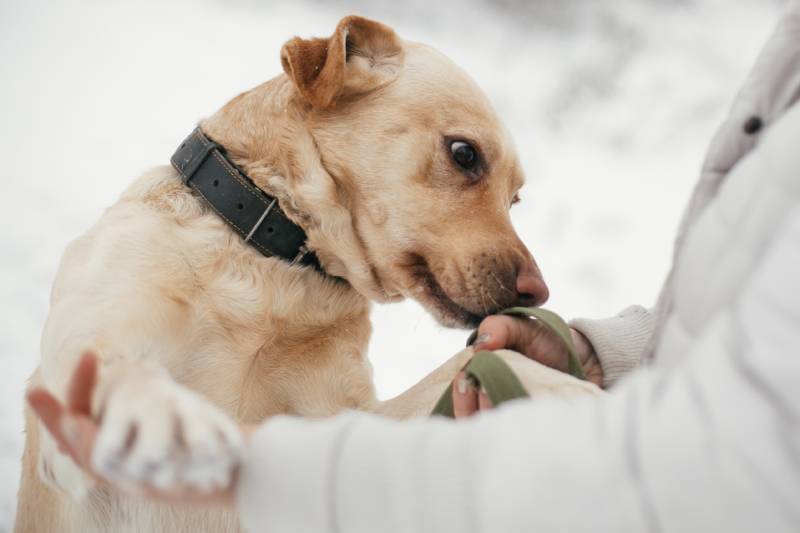Welcome to our “Ask Dr. Paola” series, where every Monday we bring expert advice straight from Dr. Paola Cuevas (MVZ) to help our readers better understand their dog’s health and well-being.
Whether you’re a new pet parent or a seasoned dog lover, Dr. Paola is here to provide answers to your most pressing questions. From nutrition tips and preventive care to troubleshooting common behavioral issues, Dr. Paola is ready to offer insights that will keep your furry friend happy and healthy. Stay tuned for expert guidance on a range of topics that matter most to you and your dog, so you can make informed decisions and provide the best possible care for your canine companion. Have a question? Send it in here! 
Help! I Want to Start Making My Own Dog Food!
“ Hey Dr. Paola, I’m wondering what is the best way to go about making homemade dog food for my dog Bowdoin. Where do I begin? ” – Drew
Hey Drew!
Making homemade dog food for Bowdoin is a fulfilling way to manage his diet and ensure high-quality ingredients, but it’s critical to provide complete and balanced nutrition. Dogs have specific dietary needs that include essential amino acids, vitamins, and minerals like calcium, iron, vitamin E, and vitamin B12. The most important point to understand here is that meeting these requirements can be challenging without careful planning and professional guidance so great efforts can have unfortunate results if not well executed.
To ensure Bowdoin receives a safe and balanced diet, start with recipes approved by a veterinarian or veterinary nutritionist. A professional can assess his dietary needs based on his breed, age, weight, activity level, and any health concerns. In many cases, supplements specifically designed for pets—such as those from BalanceIT or The Farmer’s Dog—will be necessary to meet nutritional standards.
Cooking at home also requires attention to ingredient quality and kitchen safety. Proper hygiene and handling practices are key to minimizing the risk of contamination while preparing, storing, and serving Bowdoin’s meals.
While it takes more effort to cook homemade dog food, it can be a very beautiful thing for both you and your dog. Best wishes on your dog food culinary journey!
Dr. Paola




Help! I Want to Keep My Dog Warm in Winter!
“My large black lab has terrible arthritis in his hips and legs. He’s only 7 years old and has had it since he was a puppy when he started growing fast and large. We live in the foothills of central California where the temperature has been dropping to freezing. Can we please get a little advice on how to keep warm and comfortable during the winter months? He won’t wear his jacket or anything else won’t come in if he sees us trying to put him in one?” – Mo
Hi Mo,
Sorry to hear about your lab having developmental joint issues since puppyhood. The pain and discomfort of arthritis are exacerbated by the cold temperatures. Some of the alternatives you could explore are providing him with a heated bed, or a heated dog house. Most dogs will naturally gravitate toward them when it gets cold.
You should also keep in mind that labs have a thick double-coat and were developed in the cold province of Newfoundland and Labrador, Canada. Their natural winter coat does quite a good job of protecting them against cold temperatures. It does not come naturally for many dogs to accept wearing a jacket but it can be achieved if, instead of forcing them, you gradually desensitize and train them to wear it. You will need to do this by using positive reinforcement methods.
We wish you the best with this and hope for an easy winter for your dog.
Dr. Paola




Help! My Dog Has High ALK Phosphatase Levels!
“Hello, my dog Izzy has perfect blood work except her ALK Phosphatase is 421. She is an 11-year-old mini schnauzer weighing 16 lbs. She is healthy and happy with no problems with arthritis at this time. Is it true that a mini schnauzer can have a higher ALK Phosphatase than other dogs?? please help with this question.” – Sandy
Sandi, it is true that Miniature Schnauzers can have elevated ALKP. It is also true that this marker has low specificity, which means this enzyme is produced by many cell types and can be found in the liver, bone, kidney, and intestine. Therefore, other biochemical tests are needed to interpret its significance.
ALKP is usually included in the liver panels because it is found in liver cell membranes and in the hepatic cells surrounding the small channels through which bile is released. One likely scenario is that ALKP is released into the blood when the biliary flow is slowed (the medical term for this is cholestasis). Fatty infiltrations of the liver can potentially lead to cholestasis. Therefore it is important to consider the results of other tests including TSBA, GGT, ALT, and AST, and very importantly to monitor serum triglyceride concentrations.
According to a study published by the American Veterinary Medical Association, anecdotal observations suggest that some Miniature Schnauzers with hypertriglyceridemia might develop hepatic insufficiency secondary to the pathogenic distension of the hepatic cells. Veterinarians work with different scrum chemistry panels when they make blood tests, so when you say all her blood work was perfect, I have no way of understanding what was tested. Have a chat with your vet to find out if additional diagnostic testing would seem appropriate, or if you would like some more detailed support, we recommend booking an online consultation with one of our experienced veterinarians at PangoVet. They will ask you some more questions, help provide information, and help you craft an action plan.
Best wishes!
Dr. Paola
This article is a part of our weekly Ask Dr. Paola series
